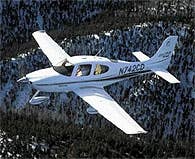
The results are in on a study looking at the safety of so-called "technically advanced airplanes" (TAAs). Conducted by a panel of industry experts assembled as part of the FAA's Safer Skies Initiative, the study examined airplanes that have technologically advanced features that are intended to make flying safer. The rather startling conclusion was that, without proper training for the pilots who fly them, technically advanced airplanes don't advance safety at all. Indeed, they can present challenges that under-prepared pilots might not be equipped to handle.
Because there's no clear dividing line between "technically advanced" airplanes and their more primitive counterparts, the panel came up with a definition that errs, if at all, on the side of simplicity. It classified as a TAA any airplane with, at a minimum, an IFR-certified GPS with a moving map display and an integrated autopilot. TAAs are not, by definition, factory new airplanes. They can be older airplanes that have been retrofitted with high-end avionics.
While it was clear that the study was undertaken at least in part because of concerns about the early poor safety record of the Cirrus SR20 and SR22 aircraft, it didn't focus on those makes but on airplanes with similar equipment. For instance, there has been a spike in fatal accidents in well equipped Beech Bonanzas of late.
At the heart of the study was a paradox, that TAAs, at least in theory, had more "available" safety, but without proper training for their pilots, they could be less safe than airplanes with less "available" safety.
As an example of the "available safety" concept, the authors pointed to IFR-approach-approved GPS navigators, such as the Garmin 430/530 series and Bendix/King KLN 94. They found that such navigators, while allowing for greater potential safety, were especially difficult for many pilots new to them. Moreover, because they require intensive pilot attention during a critical phase, approach to landing, such navigators presented considerable risks. Of interest: the study found that in general, multifunction displays, which are used to present moving map, weather, lightning and engine monitoring information, were easier for pilots to use and, therefore, did not present the same risks as approach-approved GPS navigators.
It was no shock that the study's authors concluded that something needs to be done to help pilots new to TAAs prepare better for the challenges inherent in them. What was surprising was the panel's view that existing organizations-schools, manufacturers and insurance companies-are in place and should be in position to quickly address the issue. Possible remedies include more rigorous training and higher experience standards, in addition to improved pilot-avionics interfaces, especially for GPS approach-approved navigators.

Sign-up for newsletters & special offers!
Get the latest FLYING stories & special offers delivered directly to your inbox






